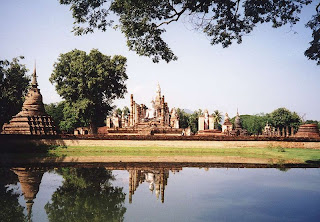Wat Phra Si Ratana Mahathat
Wat Phra Si Ratana Mahathat image was named Phra Chinarat (Victorious King), and it became the centrepiece of the monastery. All three stayed at the wat for 400 years, at which point the other two, Phra Chinasi and Phra Satsada, were moved to Wat Bowonniwet in Bangkok Considered by many to be the most beautiful Buddha image in Thailand, Phra Chinarat Buddha was cast in classic late Sukhothai style, but with the major stylistic addition of a flame-like halo circumscribing a dramatic silhouette around the head and body.
The flame halo transforms into dragon-serpent heads on either side of the image. In addition the head of the image is proportionally wider than for standard Sukhothai Buddhas, adding an impression of strength and solidity. A local bronze foundry in the city one of the most successful in Thailand does a steady trade casting Phra Chinarat copies, small and large. The wihan containing Phra Chinarat is also a masterpiece of Thai temple art.
Sukhothai Historical Park
Wat Phra Si Ratana Mahathat, which translates as Monastery of the Great Sacred Royal Gem Relic, is one of the oldest and most significant Buddhist monastery ruins in Thailand. Once a farflung Angkor satellite state, as the Angkor Empire’s power waned in the early 13th century, the principality declared its independence under Thai chieftain Phaya Si Intharathit in 1238. Si Intharathit called the new Thai kingdom ‘Sukhothai,’ the Dawn of Happiness.
Sukhothai’s third king, Ram Khamhaeng (Rama the Brave, 1279–1317), forged an important alliance with Lanna to the north,) enabling him to expand the kingdom’s influence to include most of present-day Thailand, western Cambodia, the entire Malayan Peninsula and Laos. The learned monarch also sponsored the codification of the Thai alphabet, and left behind the oldest known piece of Thai writing a stone slab inscription dating to 1292.
Before Sukhothai was annexed to the Ayuthaya kingdom (Siam) in central Thailand in 1376, its scholars and artists had helped forge key components of the Thai national identify, including literature and architecture. Sukhothai temple art and architecture combined Khmer, Thai, Sinhalese and Mon influences to forge a distinct Sukhothai flavour. Unfortunately the kingdom’s grand architecture was nearly forgotten as the centre of power moved to Ayuthaya and later to Bangkok and the neglected ancient site fell into ruin until a government restoration project was approved in 1976. In 1988, the old city site was opened to the public as Sukhothai Historical Park, and in 1991 Unesco added the site to its World Heritage list.
The 70-sq-km park contains 193 ruins Left: Northern Thailand’s most famous temple mural shows a heavily tattooed Tai Lü man flirting with a well-dressed woman. Above: This scene depicts a traditional weaving loom and Lannastyle costumes.

















0 comments:
Post a Comment